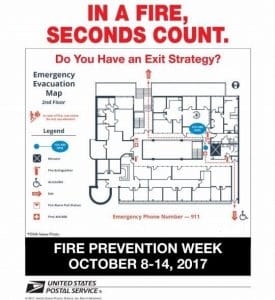 Fire can spread quickly through your home or facility, leaving you little time to safely escape. Fire evacuation plans and smoke detectors help save lives.
Fire can spread quickly through your home or facility, leaving you little time to safely escape. Fire evacuation plans and smoke detectors help save lives.
Evacuation plans must include a map of your facility or home showing two exits (windows or doors) and a path to the outside from each exit. Practice fire drills twice a year, at different times and using different ways out. At home, teach children how to escape on their own in case you can’t help them.
Nearly 2,500 people die in home fires every year in the United States. Most of these people live in homes that do not have working smoke alarms. Approximately 60 percent of home fire deaths result from fires in which smoke alarms were not present or didn’t work. Do you know how old your smoke detectors are or how often you should replace them? Replace smoke detectors every 10 years. To find out how old your smoke detector is, remove it from the wall or ceiling and look at the manufacture date on the back of the alarm.
Place smoke alarms on every level of your home, outside each sleeping area, and inside every bedroom. There are many brands of smoke alarms on the market, including alarms for people who are deaf or blind. These alarms may have strobe lights that flash or vibrate to alert those who are unable to hear standard smoke alarms when they sound. For the best protection, make sure all alarms are interconnected — when one sounds, they all sound.
Have you checked your smoke alarm to make sure it’s still working? A smoke alarm with a dead or missing battery is the same as having no smoke alarm at all. Test the alarm monthly and replace the batteries at least once a year. A smoke alarm only works when you properly install and regularly test it. Some fire departments will install battery-operated alarms in your home for free. Contact your local fire department’s non-emergency number for more information.
When evacuating a burning building, close doors behind you as you leave — this may slow the spread of smoke, heat, and fire. Once you get outside, stay outside. Never go back inside a burning building.
— Safety and OSHA Compliance Programs,
Employee Resource Management, 9-28-17
Source: USPS
